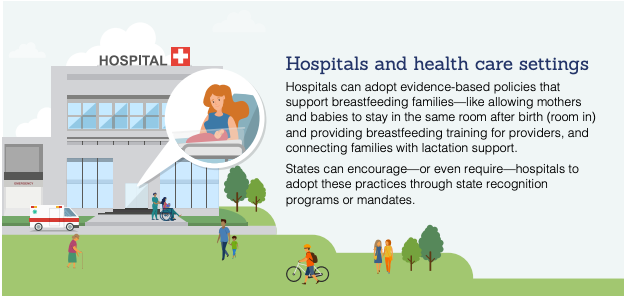Legal and policy approaches can be important tools for achieving healthier communities. A new report—The Role of Law and Policy in Assisting Families to Reach Healthy People’s Maternal, Infant, and Child Health Breastfeeding Goals in the United States—provides evidence-based information and identifies priority areas that can help communities achieve Healthy People objectives.
This Bright Spot describes the Indian Health Service’s efforts to increase breastfeeding rates in American Indian and Alaska Native communities.
Challenge: Making hospitals Baby-Friendly®
In 1991, the World Health Organization and UNICEF launched the Baby-Friendly Hospital Initiative (BFHI) to increase breastfeeding rates around the world. Participating hospitals follow policies that promote exclusive breastfeeding—like providing lactation support and keeping babies in the same room with their mothers.1
Breastfeeding provides important health benefits.2 It lowers the risk of type 2 diabetes for mothers and babies and makes it less likely that babies will develop obesity later in life.3 These benefits are especially important for American Indians (AIs) and Alaska Natives (ANs), who have disproportionately high rates of both obesity and diabetes.4
In 2011, the U.S. Department of Health and Human Services’ (HHS) Indian Health Service (IHS) started rolling out the BFHI in its federally administered obstetric facilities. The goal was to increase breastfeeding rates in AI/AN populations—and in turn improve their health by lowering rates of certain chronic diseases.
Strategy: Collaborate and set standards systemwide
IHS provides health services to approximately 2.2 million members of 567 federally recognized AI/AN tribes.5 In 2011, IHS launched an initiative with the goal of earning Baby-Friendly® designation for all federally administered IHS obstetric facilities. Baby-Friendly® hospitals need to follow the Ten Steps to Successful Breastfeeding and the International Code of Marketing of Breast-Milk Substitutes—and pass an onsite test from Baby-Friendly USA.6
To achieve this goal, IHS hospitals across the country formed task forces, created a network of practitioners to develop and share successful breastfeeding promotion strategies, updated policies, and improved medical record templates. Senior staff from IHS headquarters visited facilities to address onsite barriers, provide training and technical assistance, and conduct mock Baby-Friendly® assessments.
Anne Merewood—an Associate Professor of Pediatrics at the Boston University School of Medicine and a former IHS consultant—says that the Baby-Friendly® designation can really help ensure that hospitals are providing an equitable standard of care to mothers and their babies. “Baby-Friendly® is a leveler,” she explains. “You go in and make sure everybody has the same opportunities.”
Although some individual health care providers were resistant to implementing Baby-Friendly® changes, Merewood found through her work that community members were eager to adopt the Baby-Friendly® approach. Policies that aren’t in line with Baby-Friendly®—like those that separate mothers and babies immediately after birth—can often undermine traditional birthing practices in these communities, she says. But Baby-Friendly® policies—like skin-to-skin care and rooming-in, which keeps mothers and babies together—are in line with cultural birth and childcare practices.
Impact: Baby-Friendly® across the board
The IHS BFHI has been highly successful. Within 2 years of its launch, all 13 federally administered IHS obstetric facilities earned the Baby-Friendly® designation.7
And in line with the ultimate goal of the initiative, breastfeeding rates have increased in AI/AN populations and continue to rise as Tribal providers adopt the initiative. Among AI/AN babies:
- The rate of breastfeeding at age 6 months increased from 37.3% for babies born in 2011 to 55.0% for babies born in 2015.8
- The rate of exclusive breastfeeding through age 6 months increased from 15.6% for babies born in 2011 to 19.6% for babies born in 2015.9
“Across the country, AI/AN populations face great barriers in health care due to remote locations, chronic health issues, and a host of other reasons,” says Merewood. “It’s nothing short of heroic that these hospitals pulled this off, and if they can do it, everyone can—and they should.”
Lesson Learned: Community collaboration is key
Centering the experiences of local communities was critical to the success of the initiative. In her work, Merewood found that women from these communities were empowered to speak on behalf of their populations. “It wasn't just a consultant coming in from the outside,” she explains.
For example, when a doctor at one hospital asserted that the local tribe wasn’t interested in breastfeeding, Merewood invited a woman from the tribe’s breastfeeding coalition to speak at a hospital meeting. The woman explained that the tribe had already engaged in efforts to promote breastfeeding—and this exchange fostered more effective collaboration between the hospital and the local community.
Merewood says she sees the effects of this kind of collaboration playing out in hospitals across the country. “Instead of sending the baby to the nursery, the baby is on the mother’s chest,” she says. “They’re together in peace for an hour or more. And that, to me, is the success story.”
About the Law and Health Policy Project
The goal of the Healthy People Law and Health Policy project was to highlight how evidence-based legal and policy interventions and strategies can facilitate progress toward Healthy People 2020 targets by improving community health and well-being. In addition to reports and webinars, the project included "Bright Spots," or success stories, that highlighted successful policy interventions that led to improved health outcomes. The project was a collaboration between the HHS Office of Disease Prevention and Health Promotion (ODPHP), the Centers for Disease Control and Prevention (CDC), the CDC Foundation, and the Robert Wood Johnson Foundation.
1 https://www.babyfriendlyusa.org/for-facilities/practice-guidelines/10-st...
2 https://www.womenshealth.gov/breastfeeding/making-decision-breastfeed
3 https://www.ihs.gov/babyfriendly/benefits/
4 https://www.ncbi.nlm.nih.gov/pubmed/26561492
5 https://www.ihs.gov/newsroom/factsheets/quicklook/
6 https://www.ncbi.nlm.nih.gov/pubmed/26561492
7 https://www.ncbi.nlm.nih.gov/pubmed/26561492
8 https://www.cdc.gov/breastfeeding/data/nis_data/results.html
9 https://www.cdc.gov/breastfeeding/data/nis_data/results.html
Related Healthy People 2030 topics:






